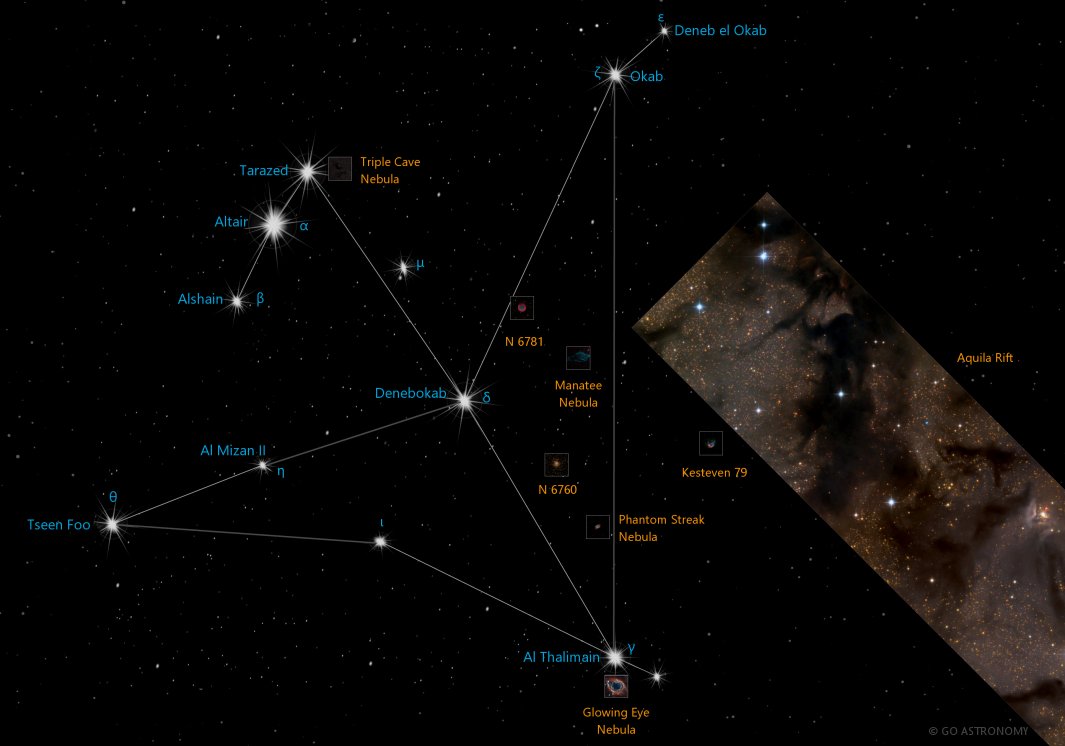Tarazed Star the Gamma Aquilae; 13 Intersting Facts
- Home
- chevron_right
- Astronomy
- chevron_right
- Tarazed Star the Gamma Aquilae; 13 Intersting Facts
Stars are enormous, luminous spheres primarily composed of plasma. Many stars orbit a central point. By observing the sky, we can identify certain recurring patterns that help us determine the location of individual stars. One such pattern is the Aquila constellation, also known as the Eagle. The celestial Eagle is composed of multiple stars, including Alshain and Tarazed, which are situated in the region of the constellation corresponding to the neck of the Eagle. Tarazed, a giant and luminous star, possesses distinctive and valuable characteristics that make it a fascinating subject for study. If you’re keen on delving deeper into Tarazed Star, continue reading this article until the end.
The Type of Tarazed Star (Gamma Aquilae)
Gamma Aquilae (Ƴ Aql), also known as Tarazed, is a prominent and colossal star within the Milky Way galaxy. It occupies a position in the upper portion of the Aquila constellation. The stellar classification of Gamma Aquilae is K3 II, which provides us with substantial information about this star. As per this classification, Gamma Aquilae appears as a radiant orange celestial object with a diameter measuring 91.81 times that of the Sun. Its luminosity allows for visibility even in regions affected by light pollution. The optimal time to observe this star is during the summer in the northern hemisphere.
But why does Gamma Aquilae possess this distinctive color and exceptional brightness? To unravel this query, we must embark on an exploratory journey into the heart of the star. Extensive studies and observations conducted by scientists have revealed that helium undergoes conversion into carbon within Tarazed stars. This chemical reaction occurs under intense heat, resulting in the star’s vivid coloration and luminosity. The surface temperature of Tarazed is estimated to range between 3500 and 5000 K, significantly hotter than the Sun. This elevated temperature stimulates various chemical reactions, including the CNO cycle. The CNO cycle is one of the two fusion reactions through which stars convert hydrogen to helium, generating energy in the process.
Similar to planets, stars revolve around a central point. Gamma Aquilae possesses a projected rotational velocity of 8 km/s, indicating that it rotates more swiftly than the Sun. By analyzing the speed of stars, scientists can estimate their age. Currently, it is understood that the Gamma Aquilae star is approximately 270 million years old. While this star rotates faster than the Sun, why is it deemed younger than our own star? Understanding the mass of Gamma Aquilae offers an explanation. Gamma Aquilae is more massive than the Sun, requiring more time to complete a single orbit. Consequently, scientists have determined that it is younger than the Sun. When observing the star on the horizon, it is notable that Tarazed is moving at a rate of -2.98 ± 0.07 milliard seconds per year towards the north and 16.99 ± 0.17 milliard seconds per year towards the east.
When studying stars, it is important to consider their velocity as well. Radial velocity pertains to the speed at which stars move either away from or toward the Sun. A positive value indicates that the star is moving farther from the Sun, while a negative value signifies its approach. The radial velocity of Gamma Aquilae is measured at -2.79000 km/s with an error margin of approximately 0.04 km/s, indicating that this star is approaching the Sun. However, in accordance with the laws of physics, we know that it will not collide with the Sun, at least within the foreseeable future.
Based on current research, it is predicted that the Tarazed star lacks sufficient mass to culminate in a supernova event. When it reaches the end of its life cycle, it is projected to shed its outer layers and assume a planetary form. Subsequently, like other planets, it will gradually fade away, ultimately becoming a white dwarf.

The Location of Tarazed Star
As previously mentioned, the Tarazed star resides within the Aquila constellation, also known as the celestial Eagle. It is distinguished as the brighter of the two stars flanking the eagle’s neck. But how do we determine the precise location of stars in the night sky? The location of bright stars is established using the celestial coordinates of Right Ascension and Declination, akin to Longitude and Latitude on Earth. Right Ascension measures the distance between a star and the Earth in terms of time, while Declination denotes the star’s position relative to the celestial equator, indicating how far north or south the star is. With this information, we can pinpoint the location of the Tarazed star at approximately 19h 46m 15.57s of Right Ascension and +10° 36´ 47.8″ of Declination.
According to the original Hipparcos data, Gamma Aquilae (Tarazed) is situated approximately 460.68 light-years away from Earth. To put this into perspective, the distance between Tarazed and Earth amounts to roughly 2,708,165,136,918,225.45 miles.

Facts about Tarazed
There are many interesting facts about the Gamma Aquilae that we mention of them in the following.
- Tarazed is approximately 3.51 times more massive than the Sun.
- With a surface temperature of 4,098 K, Tarazed is about 2.146 times brighter and hotter than the Sun.
- It is the second brightest star in the Aquila constellation.
- The apparent magnitude of Tarazed is approximately 2.712.
- Tarazed has a faster orbital speed compared to the Sun.
- In Chinese folklore, Tarazed and Alshain Stars are depicted as a couple who fell in love. However, due to societal restrictions, they were punished and placed on opposite sides of a grand river in the sky, symbolized by the Milky Way.
- If one were to walk to Tarazed, it would take approximately 66,201,597,073.31 years.
- Traveling to Tarazed in an Airbus A380 would take around 359,791,902.44 years.
- Tarazed is part of a binary or multiple-star system.
- The abundance of iron on Tarazed is estimated to be around -0.20, with an error value of 9.99 Fe/H.
- As a giant star, Tarazed is visible to the naked eye, appearing in hues ranging from orange to red.
- The diameter of Tarazed is approximately 100 times larger than the diameter of the Sun.
- A photometry catalog from 1991 suggested variations in Tarazed’s brightness, but this claim has not been definitively confirmed.
Conclusion
Tarazed has many features which are worthy to study and gaining many useful information and data about the Milky Way galaxy and whole the universe. It is one of the giant stars in this galaxy and is considered the second-biggest star in the Aquila constellation. Gamma Aquilae is significantly bigger, brighter, and hotter than the sun, but much younger than that. With spending some effort and time, we can see this giant shiny star in the night sky each time in the middle of the summer. It’s worth it!
References:
Recent Posts
- What is Gravity?
- whirlpool galaxy (Messier 51); Facts, Location, Type
- Astronomy; Definition, Types, History and Facts
- Draco Constellation; Facts, Myth, Location, Stars
- Cassiopeia Constellation: Facts, Myth, Location, Stars
- Zodiac Constellations; Facts, Stars, Symbols, Dates, Signs
- Atik Star Omicron Persei; +10 Facts, Myth, Features
- Algol Star β Persei; +10 Facts, Myth, Features
Suggest Posts
- What is Gravity?
- whirlpool galaxy (Messier 51); Facts, Location, Type
- Astronomy; Definition, Types, History and Facts
- Draco Constellation; Facts, Myth, Location, Stars
- Cassiopeia Constellation: Facts, Myth, Location, Stars
- Zodiac Constellations; Facts, Stars, Symbols, Dates, Signs
- Atik Star Omicron Persei; +10 Facts, Myth, Features
- Algol Star β Persei; +10 Facts, Myth, Features
Categories

Nazanin Teymoori
Hi there, I am Nazanin, a member of the Aquilae Constellation team. And also the author of all the texts of this blog.
I am delighted that after many years of great interest in astronomy, I launched this website with the help of our professional team. We have many challenges ahead of us, but we promise ourselves that we will overcome everything.
I love astronomy So Let's go




